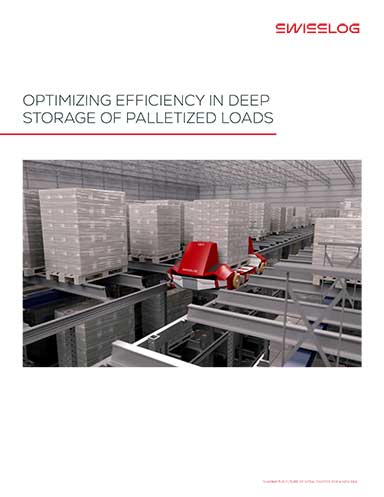A Material-Handling Odyssey for 2025

It's clear that any company not aggressively doing something about e-commerce, and how they handle material handling, is going to be at a disadvantage competitively moving forward and not just in the holiday season.
While it’s often difficult to look ahead to the end of the week, the most successful companies keep an eye on what’s coming months and years down the line. Modern Materials Handling worked with a number of industry leaders to assemble the “U.S. Roadmap for Material Handling & Logistics” based on input from more than 100 thought leaders in the industry, including educators, end users, government, NGOs, suppliers and more.
In the roadmap, the interviews and discussions led the editors to identify what they call 10 “mega trends” that represented the majority of the conversations that rose to the top as recurring themes. If you have not had a look at the roadmap, it’s important reading that can benefit anyone in the industry. A number of the mega trends especially resonated with us at FORTE, given what we’ve seen happening with our clients over the recent past.
The Changing Workforce
The editors of the roadmap cite the changing workforce as the topic that elicited “the most passionate response” time and time again. Certainly, anyone in our industry who hasn’t had his or her head in the sand can understand why.
According to MHI, analysts project that the industry will need another 1 million employees by 2030 in addition to the 11 million, or 8.6 percent of the nation’s workforce, that currently work in the supply chain. On top of this, the Bureau of Labor Statistics (BLS) indicates that the number of workers aged 55 or older will increase by 43 percent between 2008 and 2018. As that segment of the workforce ages, the overall workforce will grow by only 8 percent.
While the roadmap speaks to the clear importance of increasing recruitment and training in order to ensure sufficient labor to keep our distribution centers running, FORTE feels that this trend should also compel companies to proactively look to automation in order to lessen the burden of finding additional labor and optimize warehouse operations now. Last August, I wrote on this topic ” Will the Looming Labor Shortage Force Your Hand on Automation?”
The Growth of E-commerce
We’ve all witnessed the once-grand and busy suburban shopping malls surrounding our cities struggle to find tenants and stay relevant in today’s explosive e-commerce environment. If you examine your own shopping habits in just this past holiday season you will undoubtedly conclude that you and members of your family made far fewer “shopping trips” to physical stores in favor of online shopping.
The retail landscape has been forever changed by electronic commerce, and it’s clear that we are witnessing only the beginning of a profound transformation in the way Americans buy products.
Forrester Research estimates that online retail will comprise 10% of all retail sales by 2017, up from about 8% today. That relatively small-sounding increase is actually a 9% compound annual growth rate (CAGR) from $231 billion in 2012 to $370 billion in 2013. The report cites two underlying causes: (1) increasing use of mobile devices, leading consumers to spend more time online; and (2) traditional retailers making greater investments in e-commerce fulfillment and omni-channel distribution systems. Which is to say, demand and supply are working together to increase the size of the market.
The roadmap cites the decline of brick-and-mortar stores as a trend to watch for 2025, but it’s clear that the prognostications are already coming true. With all the inconveniences of holiday shopping driving consumers to e-commerce, a record number of online orders combined in literally the perfect storm, where bad weather over much of the United States managed to overload a system that was already bursting at the seams.
While U.S. retail growth during the 2013 holiday season is estimated to be 4.1 percent above 2012 levels, according to the U.S. Department of Commerce, e-commerce sales grew at triple that rate - 12 percent year over year. It’s clear that any company not aggressively doing something about e-commerce is going to be at a disadvantage competitively moving forward and not just in the holiday season.
But what does it mean to keep an eye on e-commerce? Your operations must be able to handle peak demand requirements whenever they occur: in a shift, in a season, in a year, and this is on top of handling projected growth. With FORTE clients routinely seeing at least 10 percent and often 30 percent or more year-over-year growth in e-commerce, they are frequently exceeding their best-guess projections.
Mass Personalization
The mass personalization mega trend ties closely with the growth of e-commerce. Although originally coined as “mass customization” by futurist Stan Davis in his 1987 book Future Perfect, this trend is fueled by the easy access provided to the product and company by e-commerce. On the low end, this can be as simple as being set up for onesy-twosey fulfillment direct to the end user with something as simple as a monogram or gift wrapping. On the high end, you have innovative companies like Nike allowing customers to customize every aspect of their running shoes.
When mass customization will get truly daunting for most companies is when customers begin to expect the same kind of instant gratification they have become accustomed to with standard, “off-the-shelf” products - ordered today, shipped today, delivered tomorrow (or today in many cases). It’s easy to see how this accelerating trend poses significant challenges for distribution. Companies have to be efficient at basic shipping, customized product shipping, value-added lines and all without sacrificing large order fulfillment (pallets, EDI, etc.).
The bottom line? We see these mega trends as reasons for companies to take a hard look at making investments in warehouse operations now to be able to scale and grow. In a blog post titled “Are Warehouses the Final Frontier for Technology Investment?” from last September, I argued that the time has come for companies to invest proactively in logistics and distribution. We think that this roadmap is a resounding call for exactly that approach.
The time to deal with your distribution operations is not when your back is against the wall. At that point, imperative and immediate considerations can override the long-term picture and compromise your ability to envision and invest in the solutions most appropriate to handle growth and future needs.
The world is too dynamic and business moves too quickly to be able to operate reactively. Companies must be proactive, and while it’s happening in most other aspects of business, the time has come to take this approach in the warehouse.













